Last updated on
Explore a variety of garage flooring ideas that can transform your drab, dull space into a vibrant and functional area.
Exploring the right garage flooring can be an exciting adventure, as it not only adds value to your home but also creates a functional and attractive space. Whether you’re looking for durability, aesthetics, or both, there are a plethora of options available.
From epoxy coatings, interlocking tiles, roll-out vinyl to concrete sealers, each offers unique benefits. This article will delve into these diverse options, providing you with in-depth knowledge to help you make an informed decision.
Stick around to uncover the details of each type, their pros and cons, maintenance needs, and installation process, ensuring you select the perfect flooring for your garage.
Epoxy Coating

Epoxy coating stands out for its durability and resistance to oil stains, beads water, and wipes clean like a kitchen counter. The coating typically includes two parts mixed together before application—an epoxy resin and a hardener. To achieve optimum results, preparation of the garage floor holds significant importance. It involves thorough cleaning to remove any contaminants and etching the concrete to ensure the epoxy bonds well.
Installation starts with priming the floor, followed by the application of the epoxy coating. Small decorative chips can be then added to the still wet first application for texture and an attractive appearance. The final step involves sealing the floor with a clear topcoat that provides additional durability.
Maintenance is a breeze with only regular sweeping and occasional wet cleaning on the schedule. With these qualities, an Epoxy coating transforms a garage into a versatile space that can withstand heavy foot traffic and resist wear and tear, making it a popular garage flooring choice.
Polyaspartic Flooring

Polyaspartic flooring has gained increasing popularity for its resilience and quick installation. Unlike other coatings, it can be applied in a wide range of temperatures, extending usage to all climates.
This flooring is known for its quick-curing time. A garage can be back in operation within 24 hours of installation, making it an ideal solution for busy families and commercial environments with minimal downtime available.
Polyaspartic flooring is UV stable, meaning it won’t yellow or fade in sunlight. This feature ensures the longevity of your floor’s color and luster in garages exposed to daylight.
Resistance to chemicals such as oil, gasoline, and salt is another key feature. Coupled with a high-gloss finish that helps camouflage dirt and dust, maintenance becomes a simple task, thus providing an everlasting aesthetic appeal.
Key recommendations for incorporating polyaspartic flooring in your garage include professional installation to ensure proper surface preparation and coating application, considering your garage’s typical usage to inform color and texture choices, and prioritizing this option if temperature fluctuations or direct sunlight are frequent.
Installing polyaspartic flooring might be a slightly high upfront investment, but its long-term benefits – easy maintenance, resilience, and a shiny new look all year round – indeed, make it worth considering.
Stained Concrete

Stained concrete is an innovative approach that enhances the rustic, earthy appeal of raw concrete while adding color and design. Utilizing acid-based chemical stains, this technique introduces varied hues and marbled effects that can approximate the look of polished stone or aged leather. It’s unique in that it does not cover up the concrete but instead transforms its surface.
An integral part of its appeal is that results are often unpredictable due to variables such as the age and composition of the concrete and the staining technique used. While this level of unpredictability may be a deterrent for some, others appreciate the one-of-a-kind finish it provides.
Choose from a rich selection of earth-tone colors which integrate seamlessly with other architectural elements in your garage. For those interested in a DIY approach, it is manageable. Basic steps include cleaning the surface, applying the stain, neutralizing the acid, and sealing to avoid unwanted wear or damage. Be mindful, though, that a professional hand in this case, due to the chemicals involved, could ensure safety and a more uniform finish.
Besides its aesthetic potential, stained concrete floors offer practical benefits as well. They are easy to maintain, just needing regular sweeping and the occasional wet mop or steam clean. Their durability allows them to withstand heavy foot traffic without showing signs of wear, and they provide excellent resistance to tire marks and oil stains, making them an excellent choice for high-use garage floors.
Rubber Tile Flooring

Opting for rubber tile flooring in your garage can offer numerous benefits. Primarily, these tiles are an excellent choice for comfort and durability. Their resilient yet supportive material provides an anti-fatigue quality, handy for long periods of standing or working. Installing them is also relatively easy, as they often come with an interlocking design, eliminating the need for adhesives.
Notably, they’re resistant to most spillages – oil, gasoline, and other car fluids won’t damage them. In terms of aesthetic, you will find rubber tiles in various colors and patterns, hence a perfect choice if you want to customize your garage floor appearance.
Rubber tiles also trump when it comes to insulation. They offer both temperature and sound insulation enhancing the functionality of your garage, especially if used for various purposes. Finally, maintenance is a breeze; sweeping or vacuum cleaning can keep them in top condition. In case of damage, you only replace the affected tile(s), saving you unnecessary costs.
However, remember to check for a high-quality pick that’s bend-resistant and able to hold heavy machinery or automobile weight. Some rubber tiles may also emit a rubbery smell, especially when new, so consider this when making your choice.
Acid-etched Concrete

Acid-etched concrete flooring offers a diverse range of stylish options for the garage – each distinct, beautiful and highly durable. As an alternative to the commonplace smooth and sometimes uninspiring garage floor, acid-etched concrete provides an opportunity to introduce color and texture, significantly enhancing the visual appeal of your space.
To create this type of floor, a mild muriatic acid solution is applied to a clean, dry concrete floor. This solution reacts with the lime in the concrete, resulting in varying shades of color and a unique, slightly rough texture that’s resistant to wear and tear.
The process includes steps such as:
- Thoroughly cleaning the concrete floor to ensure any dust, dirt, or grease is removed.
- Selecting a mild muriatic acid solution suitable for acid etching.
- Following all safety precautions while applying the acid solution, including the use of proper protective clothing and adequate ventilation.
- Allowing sufficient time for the acid solution to react with the concrete before neutralizing and rinsing it off.
- Deciding on the finishing options, which might include sealing the floor to preserve the etched pattern or leaving it natural for a more rustic look.
Certainly, opting for an acid-etched concrete floor can give your garage a personalized touch and aesthetic uplift, making it not just a place to park your car, but a space beautifully integrated into the overall design of your home.
Polyurea Floor Coating

Polyurea floor coating, known for its high durability, toughness, and rapid curing time, is rapidly becoming the coating of choice for garage floors. Here are key facts about this material to help you understand whether it’s the right choice for your garage:
- Quick to Install: Thanks to a fast curing process, a new Polyurea floor can be installed and ready to use within a day. This means minimal disruption to your garage use.
- Tough and Durable: Known for its incredible toughness, this type of coating can withstand heavy vehicle traffic, chemicals, oil spills, and even dropped tools without showing signs of damage.
- Slip-Resistant: When added texture is incorporated into the coating, it can provide a grip, preventing slips and falls, even in wet conditions.
- UV Resistant: This type of coating will not turn yellow or fade upon exposure to sunlight, maintaining its aesthetic appeal for extended periods.
- Customizable: Polyurea coating is available in an array of colors. Colored chips or flakes can also be added for more visual interest.
Steps to install Polyurea flooring:
- Prep the Floor: The first step is to ensure that the concrete substrate is clean, dry, and free of defects like cracks or chips.
- Apply Primer: Apply a compatible primer to the surface to ensure a strong bond between the concrete and the polyurea.
- Apply Coating: Once the primer is completely dry, the polyurea coating is applied. This step usually requires professional expertise.
- Add Texture: For slip resistance and a visually appealing look, texture like chips or color flakes can be thrown onto the coating while it is still wet.
While Polyurea is an excellent choice, consider factors like budget, installation process, and the specific use of the garage before making a decision. For instance, it might be too costly for large garages, and while application is quick, the installation process requires experienced professionals for the best results.
Porcelain Tiled Floor

Complementing its robust nature, porcelain tiles’ water and stain resistance ensures durability and longevity. Its aesthetic range is notable, replicating the appearance of wood, stone, or even metallic tiles without the corresponding maintenance challenges or costs.
Installing porcelain tiles can add a sophisticated and clean look to your garage. They’re optimal for garage areas that double as workshops or recreational spaces due to the ease in clean-up and resistance to chemical spills.
Key ideas for this garage flooring option include:
- Porcelain tiles offer diversity in design and can seamlessly match with any existing decor.
- They boast a high density, making them more durable than ceramic tiles.
- The impermeability of porcelain tiles makes them highly resistant to water and humidity.
Installation requires some attention, but it’s accessible for those willing to undertake a DIY project.
- Measure and map out the garage floor area to determine the number of tiles required.
- Prep the floor by cleaning and ensuring it’s level.
- Apply the tile adhesive, lay the tiles, and then apply grout.
- Allow the grout to cure before resuming use of the garage.
This flooring option shows excellence in balancing style with function, enhancing the garage’s overall look while providing a sturdy surface that withstands everyday use and possible spillages.
Interlocking Garage Floor Tiles
Constructed from heavy-duty rubber or durable plastic, interlocking garage floor tiles offer an effective and efficient way to revamp one’s garage space. Highly versatile and easily customizable, they let garage owners make their mark, offering a variety of colors and patterns to choose from.
A notable feature of these tiles is their ease of installation. The tiles simply snap together, covering the existing concrete floor without much preparation needed. The integrated pattern solves the drainage issue, allowing for the spillage or any other liquids to flow out of the garage easily.
When it comes to maintenance, the interlocking garage floor tiles provide a strong advantage. Stains and spills can be cleaned up in no time and any damaged tile can be replaced individually without huge renovation expenses. They resist oil, gasoline, and many other substances typically found in a garage.
Satisfactorily resistant to most types of wear and tear, these tiles can withstand the heavy traffic of a busy garage, making them an excellent match for hobby mechanics and DIY enthusiasts. Their impact-resistant properties protect the underlying concrete from damage, extending the life of the original floor.
Their high degree of durability combined with affordability, customizability, and ease of maintenance render interlocking garage floor tiles an appealing choice, whether one aims for functionality or aesthetics.
Polished Concrete Floors

Polished concrete is known for its sleek, high-luster finish. Achieved through a multiphase process, the pre-existing concrete floor is mechanically ground, honed, and finally, polished.
Maintenance is relatively hassle-free. Regular sweeping or mopping can keep the surface shiny, while periodic resealing will maintain its longevity.
Resistant to damage, it effortlessly withstands heavy vehicles and loads – a significant advantage for busy garages.
It brings a modern and industrial twist to any garage, offering an extensive range of colors and finishes. Acid staining, dying, and applying translucent enhancers are typical methods applied to change its original color.
Insulation properties seduce both eco-conscious and budget-conscious homeowners, aiding in thermal regulation and reducing lighting needs due to its reflective nature.
Installation by a professional is recommended – for both the complexity of machinery required and expertise to create a flawless finish.
Despite the initial expense, polished concrete floors are an investment, providing durability and visual appeal in a garage setting.
Peel and Stick Tiles
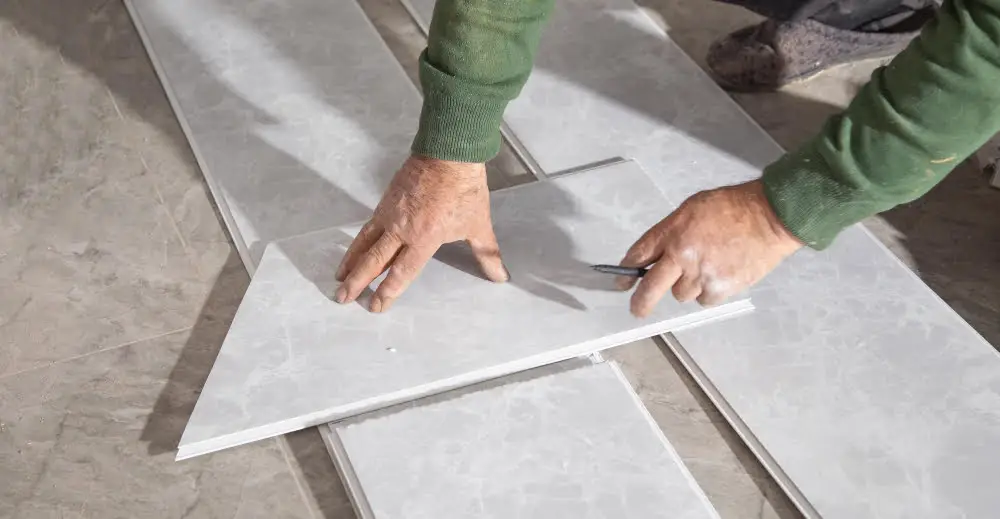
Peel and stick tiles offer a simple, cost-effective solution for sprucing up garage spaces. Once set, these tiles create a smooth, resilient surface that is easy to clean and maintain. Their availability in various colors and patterns allows for customization of the garage space to personal tastes.
Key aspects of peel and stick tiles for garage flooring include:
- Ease of installation: Peel and stick tiles require no specialized tools, and the work can be done within a day depending on the size of the garage.
- Durability: Much like other floor covering solutions, these tiles offer a durable surface. Made from stain-resistant, durable vinyl, they can withstand heavy machines, vehicles, and foot traffic.
- Versatility: Available in numerous colors, patterns, and textures, they offer significant room for customization.
- Maintenance: Cleaning them is straightforward— warm soapy water and a mop suffice.
Steps anyone can follow to install peel and stick tiles are as follows:
- Ensure the garage floor is dry, clean, and free of any grease or oil.
- Measure the area of the garage to determine how many tiles are required.
- Start from the center, peel off the backing, and press the tile onto the floor.
- Repeat the process, ensuring the tiles fit closely together.
- Cut extra tiles to fit any corners or edges.
Remember, peel and stick tiles cannot cover major cracks or uneven surfaces. So, if the garage floor is heavily damaged, consider applying a self-leveling compound before laying out the tiles.
Carpet Tiles
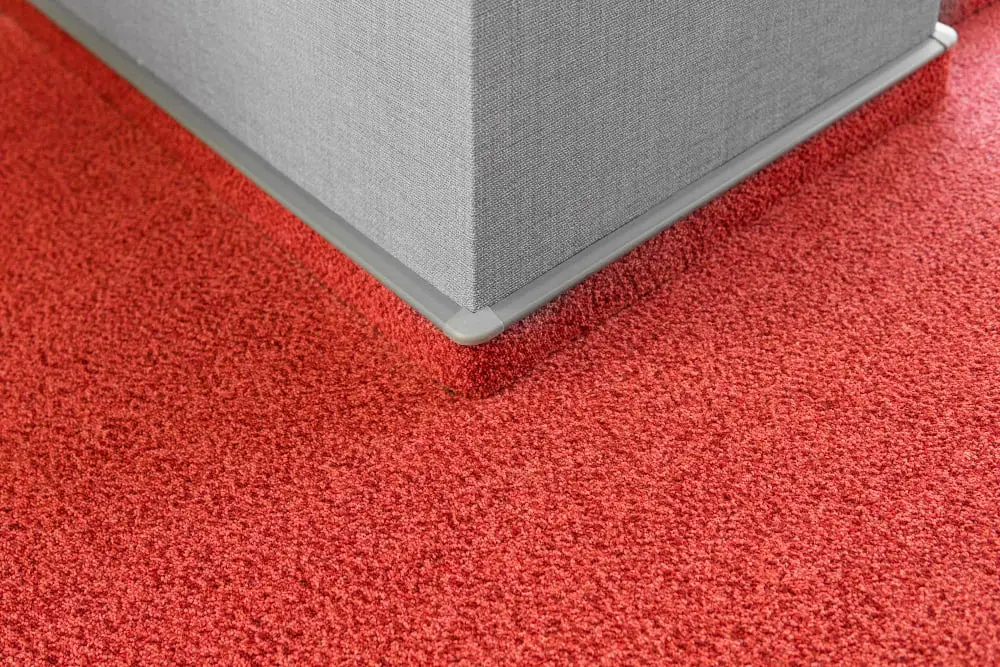
Carpet tiles, often chosen because of their convenience and aesthetic diversity, serve as an excellent flooring option for your garage. They can be quickly installed without professional help, making them a do-it-yourself friendly choice. Each tile comes separately, allowing for an assortment of patterns – an appealing feature to those desiring a unique and customized look.
Equipped with a sturdy, hard-backing, these tiles stand up well under heavy use and resist damage. Their textured surface offers traction to prevent accidental slips, important in the garage where oil or other slick substances might spill. Besides, they offer an insulating effect, which can help keep a garage warm during colder months.
Cleaning is straightforward; most grime can be handled with a vacuum while more stubborn stains can be treated by removing the individual tile for a deep-clean or replacement. It’s important to note, however, that carpet tiles are not suitable for garages encountering frequent wet conditions, as they may absorb water and become susceptible to mold.
By considering the use, climate, and personal style preferences, one can effectively decide whether carpet tiles are the best choice for their garage flooring.
Rolled Rubber Flooring

Rolled rubber flooring is a popular choice for garage spaces due to its various attributes that make it ideal for such environments. It is made from recycled rubber, reducing waste while providing both safety and durability features.
Here are the key ideas when considering rolled rubber flooring:
- Versatility: The flooring is available in a wide range of colors and thicknesses, making it a versatile option for different garage aesthetics and uses.
- Durability: It can withstand high-traffic areas, preventing wear and tear damage. It is also resistant to stain, weather-related damage, and chemical spills.
- Comfort: Despite its toughness, the flooring provides a comfortable surface that is gentle on the feet.
- Installation: Rolled rubber flooring’s installation is doable as a DIY project. Cut to fit your garage dimensions, roll out, and adhere it down with either adhesive or double-sided tape.
- Sound Reduction: It significantly reduces noise which can be beneficial in garages used for more than just vehicle storage.
- Maintenance: Cleaning and maintaining such flooring is relatively easy. Regular sweeping or vacuuming can remove debris, and a mop with mild soap can manage stains or spills.
- Sustainability: It is both eco-friendly and sustainable due to its use of recycled materials.
To pick the best option, factor in the garage’s primary usage, the local climate and weather conditions, and the preferred level of maintenance.
Garage Floor Mats

Garage floor mats are an excellent choice for homeowners looking for a quick and hassle-free installation process. These mats come in a variety of styles, making it easy to find a design that matches your garage’s aesthetics.
Characterized by their robust, robust design, such mats are resistant to different types of damages, including oil spills, tire marks, and other harsh elements. They provide a robust combination of style and durability.
Roll-out garage floor mats are a notable variety. You just unroll them on your garage floor, cut as necessary to fit, and you are done with your install. Besides the ease of installation, these mats also offer easy maintenance. Most of them can be easily cleaned with regular soap and water.
Interlocking garage floor mats are another attractive option. They come as a set of interlocking tiles, giving you the flexibility to customize the flooring layout as per your garage’s dimensions. You can choose from different colors and patterns to create a unique look.
To keep these mats in pristine condition, regular cleaning is key. A soft brush and gentle, pH-neutral cleaning detergent are often enough for general cleaning. For tougher stains, a mixture of hot water and vinegar can often do the trick. Follow the manufacturer’s cleaning guidelines to ensure longevity.
Installation of garage floor mats is a simple, under-an-hour, DIY project. All you need is the mat, a cutting tool for trims, and possibly some adhesives for a more secure installation. Choosing this flooring option may save you professional installation fees, and best of all, instantly upgrade the look and feel of your garage.
Outdoor Carpeting

Outdoor carpeting offers unique advantages for a garage floor. It’s capable of withstanding heavy foot traffic and offers a cosy aesthetic often not associated with a garage. It’s especially ideal for garages that double as a space for entertaining or lounging.
Some of the key benefits of this flooring option include:
- Comfort: Outdoor carpets can provide a softer, warmer surface compared to concrete or other hard surface flooring.
- Versatility: Available in a variety of colors and patterns, this option allows you to create any desired look.
- Durability: Outdoor carpeting is designed to withstand different weather conditions, making it a resilient choice for areas like garages.
- Installation Ease: This carpeting can simply be rolled out onto the floor with a double-sided tape or adhesive. Just ensure the floor is thoroughly cleaned before installation.
Maintaining an outdoor carpet is easy too. Regular vacuuming can help keep the carpet clean, whilst quick action on spills will prevent stubborn stains. Mild detergent or carpet cleaner can be used for deep cleaning if needed.
However, a drawback is that outdoor carpeting can be susceptible to mold and mildew if it frequently gets wet and isn’t properly dried. Therefore, it’s critical to ensure proper ventilation in your garage to prevent excess moisture buildup.
Stone Flooring
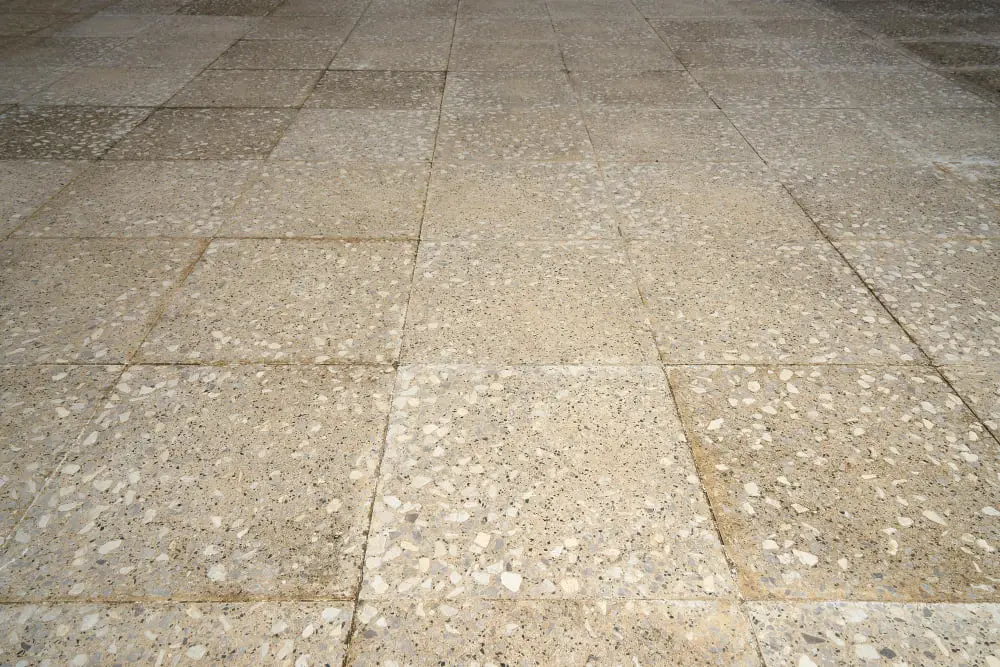
The character and sophistication of stone flooring might seem an extravagant choice for a garage, yet its durability and range of available styles make it a highly suitable consideration. They stand as a prime example of long-term resilience, withstanding heavy loads, extreme temperatures, and daily wear and tear well.
Many realize the benefits of stone flooring once installed – it’s easy to clean, often needing only a quick sweep or mop down. For tougher dirt, a simple mixture of warm water and a mild detergent acts as sufficient cleaning solution.
Adding to their appeal, stone floors require minimal maintenance. Periodic sealing depending on the stone type is usually enough to keep the floor in top shape.
The sheer variety of stone flooring can transform your garage into a stylish extension of your home. Options like granite known for its toughness, or slate that offers a unique, rustic charm or marble for a touch of unrivaled elegance are widely preferred. An essential aspect to consider while selecting a particular stone is its slip resistance, especially if your location gets a lot of rain or you plan to wash your car in the garage.
Something to note – stone floors can be a more costly option. However, its durability lowers the cost in the long run, given the infrequency of replacements and repairs.
In terms of installation, it’s recommended to consult with a flooring specialist. This can ensure a long-lasting, properly leveled floor, maximizing the benefits of your chosen stone.
Finally, bonus points for environmental consciousness. Stone floors, being a natural product, contribute to a greener environment compared to synthetically produced alternatives.
Solid Wood Flooring

Solid wood flooring is an often-overlooked choice for garage spaces, one which adds a touch of class and durability to this functional area of the home. Offering both aesthetic appeal and robustness, solid wood stands as a testament to timeless elegance.
Primarily, this flooring option is highly durable, and with the right care and maintenance, it can serve for many years. An easy-to-clean surface is another advantage, as regular mopping and sweeping can keep it looking as good as new.
To install this type of flooring, it’s pivotal to ensure the garage floor is level for stability and longevity. Essentially, surface preparation involves cleaning and clearing any debris or dust before proceeding with the installation.
One attractive feature of solid wood floors is their flexibility to be refinished, which can be done when signs of wear and tear appear, giving the floor a fresh new look. Meeting the challenge of garage conditions, some opt for harder wood species, such as red oak or maple which can withstand the rough and tumble nature of a garage’s usage.
However, it’s worth noting that wood can be susceptible to damage from moisture or extreme temperature fluctuations. It translates to ensuring proper insulation and possible employing climate control in the garage to safeguard your investment.
Finally, the aesthetic versatility of the wooden floor is a major prize, with numerous finishes, kinds and colors to choose from. This affords the opportunity to create a truly unique space that complements the rest of the home’s decor.
Laminate Flooring

Implementing laminate flooring in a garage is a practical and cost-effective solution. This hardy material can withstand the daily wear and tear associated with a busy garage space.
Another reason homeowners choose this route is installation convenience. Most laminate flooring comes in interlocking planks, which can be easily fitted together without the need for any adhesive or nails. The underlayment, often attached to the back of each piece, aids in soundproofing and adds resilience to the floor.
Maintenance is quite straightforward, requiring simple sweeping or vacuuming to remove dust and debris. Spills are not a significant concern, as laminate flooring is resistant to most stains. However, flooding or serious water damage can lead to warping, thus it’s crucial to ensure the flooring area is dry and free from leaks before installation.
Now, while the aesthetics of laminate flooring are versatile, carrying the potential to mimic the look of hardwood or stone, it does have a shorter lifespan compared to other garage flooring options. Depending on the amount of traffic and wear, it may need replacing in about 10-15 years.
Upgrading the garage with laminate flooring is a tangible step to add both durability and style. Yet, like every flooring choice, it calls for a balanced consideration of its pros and cons to match specific user needs and lifestyle. Despite its potential vulnerabilities, its ease of installation and overall cost-effectiveness make it a popular choice for many homeowners.
Vinyl Composite Tile
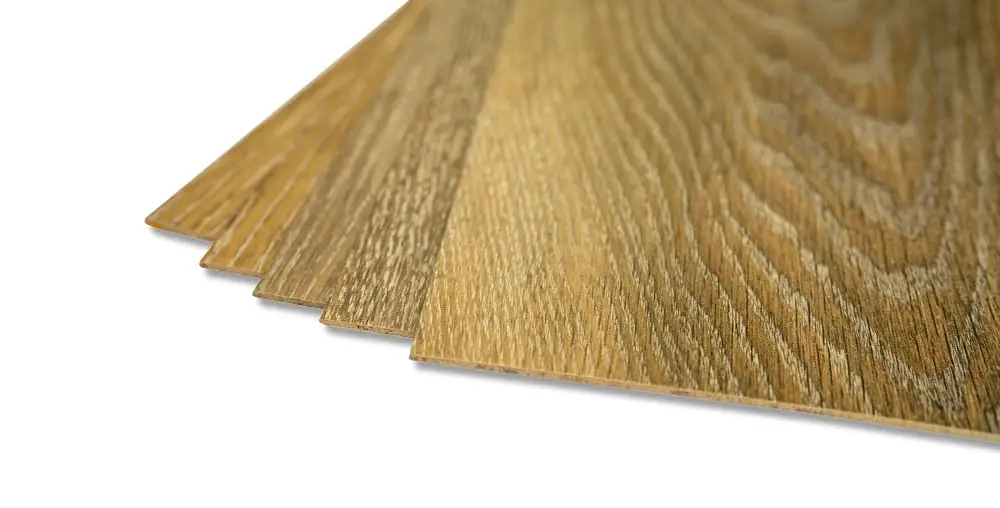
As a highly recommended pick among homeowners, vinyl composite tile (VCT) has several striking features that make it a brilliant choice for garage flooring.
Characterized by its durability and resilience, VCT is renowned for its ability to withstand heavy traffic and impact damage. This quality alone makes it ideal for spaces like the garage that can see a lot of vehicular movement and heavy-duty activity.
This type of garage flooring allows for customizability as it is available in a wide array of colors and patterns. You can comfortably choose a design that complements your home’s aesthetic and your personal taste. Its spectral variety and design versatility is another major advantage that arises from choosing this flooring option.
Ease of installation is another distinguishing feature of vinyl composite tile. The installation process typically involves the adherence of the tile onto a leveled sub-floor using an appropriate adhesive. To ensure longevity and maintain a clean appearance, the floor may then be sealed using a commercial-grade wax.
Maintenance and cleaning of VCT is straightforward. Regular sweeping and damp mopping are usually sufficient to keep the flooring clean and in pristine condition.
One vital point to bear in mind when selecting VCT garage flooring is its susceptibility to stains from substances such as oils and chemicals. Therefore, a high-quality top coat to protect your floor from stains and spills is advisable.
Bear in mind:
- Consider the durability and resilience of VCT.
- Explore and experiment with the wide array of customizable color and pattern options.
- Ensure to install it correctly with an appropriate adhesive and a commercial-grade wax.
- Perform regular sweeping and damp mopping to maintain cleanliness.
- To protect from potential oil and chemical stains, apply a protective top layer.
Painted Plywood
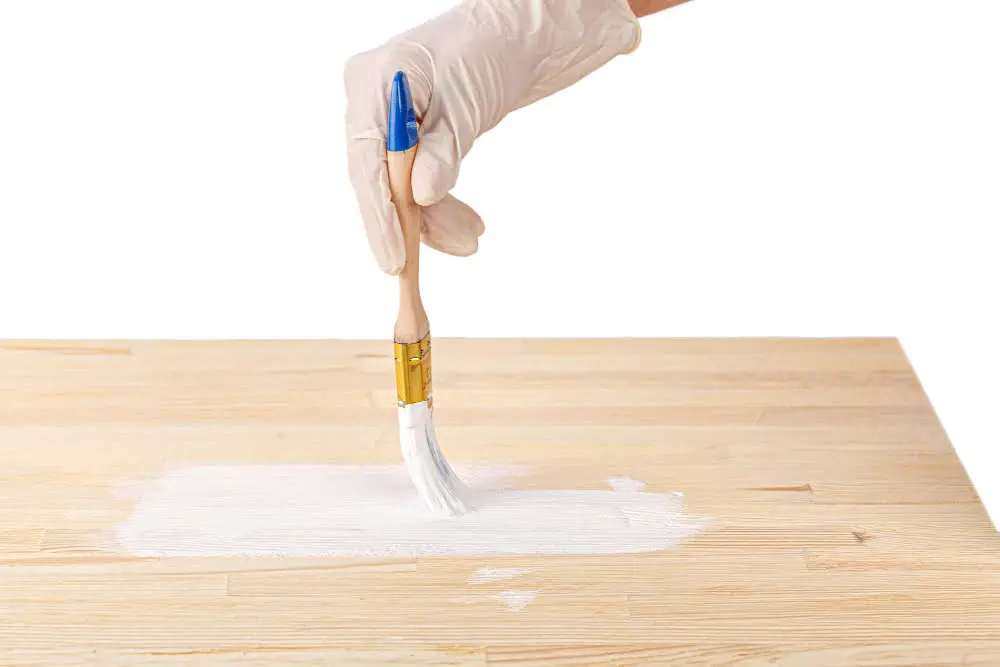
Painted plywood offers an affordable and customizable flooring option for your garage. Its installation process is straightforward, and it provides a chance for DIY enthusiasts to exhibit their skills.
Plywood proves to be a robust material, capable of withstanding moderate to heavy garage traffic. Ensure you are using a grade of plywood suitable for flooring, indicating its resistance to potential water damage.
Once you’ve acquired the right plywood, the first order of business is surface preparation. This involves clearing any dirt or debris away before applying a primer. This preparatory step is vital in enhancing the durability of the paint job.
Your choice of paint should be informed by its ability to resist wear and tear typical of a garage environment, making epoxy paint a popular choice among homeowners. It is recommended to apply at least two coats of paint for an even finish, and to guarantee longevity.
Care for your painted plywood floor ensures it maintains its appealing look for a longer period. Regularly sweeping or vacuuming to remove dust and using a damp mop for deeper cleaning should be sufficient. Avoid copious amounts of water during cleaning to prevent the water from seeping into the plywood layers.
For any paint touch-ups or full repaints in the future, follow the same procedure – prepping the surface before applying the primer and paint. Painted plywood floors should ideally be repainted every two to three years, but this largely depends on the level of use and amount of traffic your garage bears.
Terrazzo Flooring
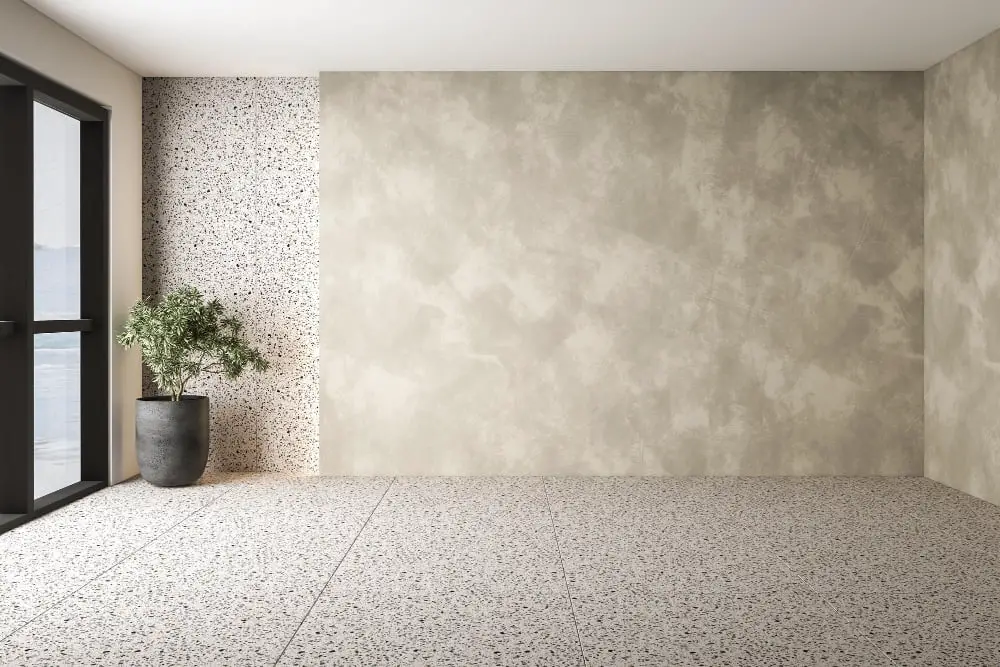
Terrazzo flooring, a timeless choice, offers both aesthetic appeal and durability. It’s a composite material created with multiple chips of different sizes from marble, quartz, granite, or glass. These chips are poured with a binder that can be either cementitious, for an old-world look, or epoxy-resin, for higher performance and endless design options.
When it comes to installing terrazzo flooring in your garage, consider its attributes. Firstly, it’s remarkably durable and resistant to high traffic, making it ideal for a space like a garage. Additionally, it’s easy to maintain; an occasional sweep and mop are all it takes to keep a terrazzo surface clean.
Another attractive feature of terrazzo flooring is its versatility. It can be customized to match your garage’s aesthetic as you can choose the color, type of chips used, and size of chips. This gives your garage floor a unique but polished appearance.
Moreover, terrazzo flooring is also environmentally friendly. It often involves using recycled materials, adding a sustainable aspect to its appeal.
Be aware, however, that installing terrazzo flooring can be complex and might require professional help to ensure a smooth, seamless surface. Trustworthy flooring contractors can give a better lifespan for your garage floor with proper installation.
Finally, while it’s a more expensive option compared to others, many find that the longevity and durability of terrazzo makes it well worth the investment in the long run.




